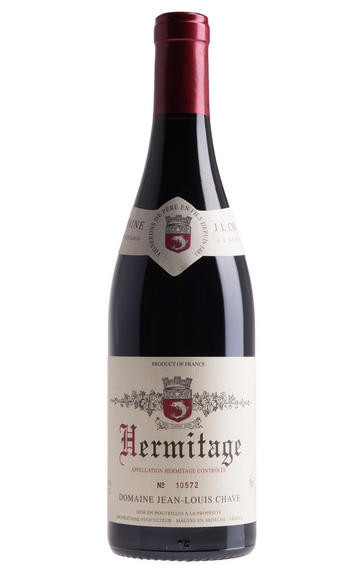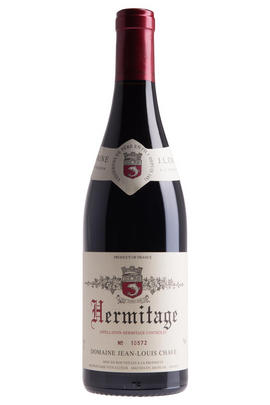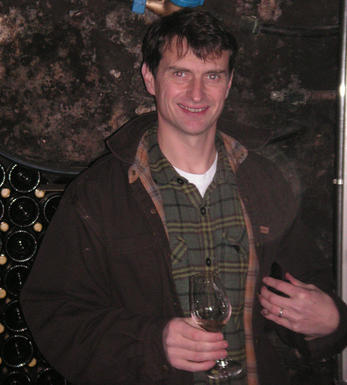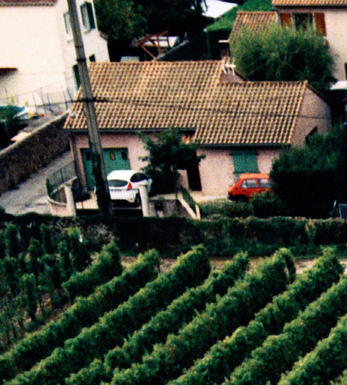
2003 Hermitage Rouge, Domaine Jean-Louis Chave, Rhône

Critics reviews
Chave's 2003 Hermitage, like the most successful Burgundies from that anomalous vintage, somehow retains a sense of mineral freshness that balances this wine's remarkable concentration and massive fruit. Tasted at the domaine, it's even floral and perfumed on the nose, an incredible feat when faced with that summer's implacable heat. Full-bodied, massively rich and decadently creamy in texture, it delivers waves of mixed red and black fruits that avoid any overtly raisiny character, finishing vibrant, peppery and long.
Jean-Louis Chave seems increasingly confident at the helm of this legendary domaine. We spent some time discussing the 2018 vintage, which he rates highly. "The wines are not really jammy. They're almost as ripe as 2003, but for some reason, the grapes weren't raisiny," he said. "The vines never really stopped. In mid-August, we had 40 millimetres of rain—perfect timing. And at the end of August, another little rain."
Hermitage shines this year. "In Hermitage, you can push things to the limit and still be OK," Chave said. "Even when it's extreme, the grands terroirs are still the grands terroirs." Looking at recent vintages, Chave summarized the similarities as follows: 2015, he compares to 1990; 2016 to 2010; 2017 to 2000. As for 2018, said Chave, "It wouldn't be right to compare 2018 and 2003. The ripeness is extreme, but in the end, they're very different wines."
Hermitage aside, Chave has spent much of his time in recent years working on his vineyards in Saint Joseph. He said he thinks of Saint Joseph as a wine for bistros rather than haute cuisine, but Chave's Saint Joseph's have quickly progressed beyond that in terms of quality (and, unfortunately, price).
Drink 2015 - 2040
Joe Czerwinski, Wine Advocate (December 2019)
The perfect 2003 Hermitage has acquired extraordinary minerality and definition since I first tasted it 12 months earlier. Its inky/purple colour is accompanied by glorious aromas of creme de cassis, black cherries, liquorice, crushed rocks, and flowers. Prodigiously rich and full-bodied yet elegant and fresh, this is a tour de force in winemaking. This extraordinary Hermitage has no overripe, scorched, pruny, fig-like notes. It will be drinkable young yet evolve for 35-40+ years.
Drink 2006 - 2046
Robert M. Parker, Jr., Wine Advocate (February 2006)
I’ve rated the 2003 Hermitage perfect numerous times, and while sound bottles are still as good as it gets, I’ve also had some tired bottles here in the States, so provenance is critical with this vintage.
Still youthfully coloured yet just starting to show some maturity in its aromatics of blackberries, dark currants, liquorice, spice box, and leather, this fabulously textured, opulent 2003 hits the palate with full-bodied richness, a wealth of sweet tannins, and a monster of a finish.
Clearing 15% alcohol (and I think the pH is probably around 4), it should be a required tasting for all those touting the low alcohol nonsense. This singular beauty can be drunk today with incredible pleasure or cellared for another two decades, if you’re so inclined.
Drink 2020 - 2040
Jeb Dunnuck, JebDunnuck.com (February 2020)
About this WINE

Chave
The Chaves have been growing vines on the famous Hermitage hill for over 500 years. Gérard Chave took over from his father in 1970 and rapidly achieved megastar status due to the extraordinary quality of his wines. The easte is currently under the helm of University of California Davis graduate Jean Louis Chave, although his father Gerard still plays an active role.
The domaine produces a red St Joseph 'Offerus' (made in equal proportions from senior vines in Mauves and St –Jean-de Muzols), an acclaimed Vin de Paille, but their reputation is built on their superb red Hermitage (Syrah with the addtion of 15% white grapes) and white Hermitage (85% Marsanne and 15% Roussanne).
The Chaves own 15 hectares of vines on the Hermitage and crucially their Hermitage holding is spread across 9 of the 18 climates on the hill (incl. Les Bessards, the adjucent Le Méal, Les Roucoles, Maison Blanche and the monopoles L'Hermite and Peléat). This means that they can produce a blend which reflects the separate "terroirs" of the climates and is a perfect balance between aromatic complexity, power and finesse.
The grapes are partially de-stemmed and then fermented in a combination of open wooden vats and cement cuves. The wine is matured in a combination of large wooden foudres and small wooden casks (a proportion of which will be new) for 12-18 months. All Chave wines are bottled unfiltered.
J.L. Chave Sélection is the exclusive négociant label of Jean-Louis Chave, the doyen of Hermitage wine, and offers the perfect solution for those who adore the great wines from this appellation but not the price tag of Chave’s main label.

Hermitage
Hermitage is the most famous of all the northern Rhône appellations. The hill of Hermitage is situated above the town of Tain and overlooks the town of Tournon, just across the river. Hermitage has 120 hectares and produces tiny quantities of very long-lived reds.
The vines were grown in Roman times, although local folklore claims their origins to be nearly 600 years earlier. The name ‘Hermitage’ first appeared in the 16th century, derived from a legend of the 13th century Crusade, involving a wounded knight called Gaspard de Stérimberg, who made refuge on the hill, planted vines and became a hermit.
During the 17th century, Hermitage was recognised as one of the finest in Europe. In 1775, Château Lafite was blended with Hermitage and was one of the greatest wines of its day. In the late 19th century, however, Phylloxera wiped out all the vineyards.
The wines are powerful, with a deep colour and firm tannins, developing into some of the finest examples in France, with the potential to age for many decades. The best Hermitage is produced from several climats or more, blended together. The main climats are Les Bessards, Le Meal, L’Hermite, Les Greffieux and Les Diognieres. Most of the finest climats face broadly south, giving maximum sunshine. Most growers only have one or two climats and they might not complement each other; Hermitage quality can therefore vary hugely. Only the top producers have extensive diversified holdings.
80% of the wine produced is red, however up to 15% of white grapes can be used in the blend. Most growers use 100% Syrah and utilise the white grapes to make white wines only. Chapoutier, Jaboulet and Tain l'Hermitage are the principal proprietors of the appellation’s vineyards.
The white wines are made from the Marsanne and Roussanne grapes. Great white Hermitage can age, taking on the fruit characters of apricots and peaches, often giving a very nutty finish. The best examples in great vintages can last 50 years.
Mature red Hermitage can be confused with old Bordeaux. In a blind tasting of 1961 First Growth Clarets, the famous 1961 Hermitage La Chapelle was included. Most people, including its owner, Gerard Jaboulet, mistook it for Château Margaux.

Syrah/Shiraz
A noble black grape variety grown particularly in the Northern Rhône where it produces the great red wines of Hermitage, Cote Rôtie and Cornas, and in Australia where it produces wines of startling depth and intensity. Reasonably low yields are a crucial factor for quality as is picking at optimum ripeness. Its heartland, Hermitage and Côte Rôtie, consists of 270 hectares of steeply terraced vineyards producing wines that brim with pepper, spices, tar and black treacle when young. After 5-10 years they become smooth and velvety with pronounced fruit characteristics of damsons, raspberries, blackcurrants and loganberries.
It is now grown extensively in the Southern Rhône where it is blended with Grenache and Mourvèdre to produce the great red wines of Châteauneuf du Pape and Gigondas amongst others. Its spiritual home in Australia is the Barossa Valley, where there are plantings dating as far back as 1860. Australian Shiraz tends to be sweeter than its Northern Rhône counterpart and the best examples are redolent of new leather, dark chocolate, liquorice, and prunes and display a blackcurrant lusciousness.
South African producers such as Eben Sadie are now producing world- class Shiraz wines that represent astonishing value for money.


Buying options
Add to wishlist
Description
Chave's 2003 Hermitage, like the most successful Burgundies from that anomalous vintage, somehow retains a sense of mineral freshness that balances this wine's remarkable concentration and massive fruit. Tasted at the domaine, it's even floral and perfumed on the nose, an incredible feat when faced with that summer's implacable heat. Full-bodied, massively rich and decadently creamy in texture, it delivers waves of mixed red and black fruits that avoid any overtly raisiny character, finishing vibrant, peppery and long.
Jean-Louis Chave seems increasingly confident at the helm of this legendary domaine. We spent some time discussing the 2018 vintage, which he rates highly. "The wines are not really jammy. They're almost as ripe as 2003, but for some reason, the grapes weren't raisiny," he said. "The vines never really stopped. In mid-August, we had 40 millimetres of rain—perfect timing. And at the end of August, another little rain."
Hermitage shines this year. "In Hermitage, you can push things to the limit and still be OK," Chave said. "Even when it's extreme, the grands terroirs are still the grands terroirs." Looking at recent vintages, Chave summarized the similarities as follows: 2015, he compares to 1990; 2016 to 2010; 2017 to 2000. As for 2018, said Chave, "It wouldn't be right to compare 2018 and 2003. The ripeness is extreme, but in the end, they're very different wines."
Hermitage aside, Chave has spent much of his time in recent years working on his vineyards in Saint Joseph. He said he thinks of Saint Joseph as a wine for bistros rather than haute cuisine, but Chave's Saint Joseph's have quickly progressed beyond that in terms of quality (and, unfortunately, price).
Drink 2015 - 2040
Joe Czerwinski, Wine Advocate (December 2019)
wine at a glance
Delivery and quality guarantee